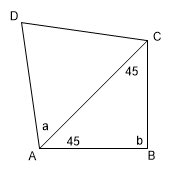niketriantafillidis@gmail
New member
- Joined
- Apr 22, 2022
- Messages
- 3
Can you post an image of the exact assignment ? I suspect some information is missing. As posted the rectangle is not unique.Hi! Would appreciate some help on this. Don't know where to start without any given angles.
View attachment 32312


I had this assignment on a resent test, which I don't have access to and they only gave us the answers to the questions and not the calculations. I'm not a 100% sure but there might have been a 90 degree angle in the bottom right corner and maybe one in the left one at the top. The answer is suppose to på A=B=10.
You can get A and B = 10 if you assume the lower right corner is a right angle. Look at the diagram below:
Since ABC is a right triangle with legs of 10 you can calculate its hypotenuse to be 20. You are given sides AD and CD so you can calculate cosa using the law of cosines. Then use the addition formula for cosV=cos(a+4π) and simplify it to get your answer.
You're misreading the problem. It doesn't say A and B are angles or lengths. It says this:What are A & B, indeed?
You don’t mention A & B anywhere on your sketch! ?

You can get A and B = 10 if you assume the lower right corner is a right angle. Look at the diagram below:
View attachment 32321
Since ABC is a right triangle with legs of 10 you can calculate its hypotenuse to be 20. You are given sides AD and CD so you can calculate cosa using the law of cosines. Then use the addition formula for cosV=cos(a+4π) and simplify it to get your answer.
Thanks for your answers!What are A & B, indeed?
You don’t mention A & B anywhere on your sketch! ?
So how are we supposed to know what is to be calculated? ?
Assuming there is a right angle in the bottom right corner then there cannot also be one in the top left or the side lengths wouldn’t be consistent with the those provided. Furthermore, if the answers given (A=B=10 & cosV = BA) are correct then cos V = 1010⇒ V ≈ 71.6°. If V were obtuse (as per LCK's sketch) then cos V would be negative, so I would suggest the figure should look more like this:-
Unlike LCK, I would name the vertices in a clockwise direction (as per the second figure) but that’s nothing more than a matter of preference, however, given that my sketch appears to fit the dimensions (& answers) provided, so far, I am still at a loss to know what the A & B actually are!
Are A & B line lengths or angles or areas or what?PS: I have no idea why that "View attachment 32331" appears above! ?
Since you seem to have observed I named the vertices in a counterclockwise direction ABCD and I mention triangle ABC, I think you know they are labels of the vertices. When I drew the figure in another application I forgot the OP had used A and B to represent numbers in his answer. Mild slip-up. Please try not to hyperventilate too much about it.What are A & B, indeed?
You don’t mention A & B anywhere on your sketch! ?
So how are we supposed to know what is to be calculated? ?
Assuming there is a right angle in the bottom right corner then there cannot also be one in the top left or the side lengths wouldn’t be consistent with the those provided. Furthermore, if the answers given (A=B=10 & cosV = BA) are correct then cos V = 1010⇒ V ≈ 71.6°. If V were obtuse (as per LCK's sketch) then cos V would be negative, so I would suggest the figure should look more like this:-
Unlike LCK, I would name the vertices in a clockwise direction (as per the second figure) but that’s nothing more than a matter of preference, however, given that my sketch appears to fit the dimensions (& answers) provided, so far, I am still at a loss to know what the A & B actually are!
Are A & B line lengths or angles or areas or what?PS: I have no idea why that "View attachment 32331" appears above! ?
You're misreading the problem. It doesn't say A and B are angles or lengths. It says this:
A and B are the radicand and the denominator in the answer, written in this form; since the answer (under @LCKurtz's interpretation) is cos(v)=1010
we get A=10,B=10.
You’re quite right, of course, Dr.P.Since you seem to have observed I named the vertices in a counterclockwise direction ABCD and I mention triangle ABC, I think you know they are labels of the vertices. When I drew the figure in another application I forgot the OP had used A and B to represent numbers in his answer. Mild slip-up. Please try not to hyperventilate too much about it.
